free to be able to rate and comment on reports (as well as access 1:25000 mapping).
This is the continuation of the report from a long walk across Europe in 2003-4.
The first part of the report can be read on this link. The previous post can be read
here.Day 42The pilgrim route is over. It's an amazing feeling that the first stage of our journey is now behind us; the
camino seems to have taken an eternity in itself. But the future looks good - we’re excited to finally be heading away from busy roads and organised hostels; from here on, we’re really on our own.
After a few miles of forest tracks we reach the tiny hamlet of Fabrica de Orbaceita, where we join a new long-term friend – the Gran Recorrido 11 or GR11. This is a recently-created long distance footpath which leads through the Spanish Pyrenees from the Atlantic to the Mediterranean, but it is only very occasionally marked with red and white paint splashes.
Immediately from the hamlet it begins a tough, sweaty climb into the huge rolling green hills which here make up the Pyrenees. It’s not just the gradient that is tougher than anything on the camino; the route is also badly overgrown and difficult to follow.
High in the hills we reach a tiny shepherds hut. As we approach, three huge barking dogs leap out, one of them running straight for us, snapping and snarling with bared teeth. We begin to walk quickly backwards as we daren’t turn away from it, but luckily for us the dogs' shepherd master, living in the hut for the summer months, comes out to our rescue. After much yelling he has the dogs back inside. It’s hard to believe anyone could be living such an isolated and basic existence in western Europe; the shepherd has only a wooden shack with no facilities of any kind. He has an enormous grey beard and doesn’t speak much; however he does point us on our way, contouring the slopes through the bracken.
An hour later there’s no longer any path at all and we’re stumbling desperately steeply downhill into the woods, before again picking up a route down the pastures of the valley floor - our destination for the day. Out comes the tent in this lonely spot for our first truly wild camp.
There’s a beautiful river here, where we first wash our clothes and then enjoy a swim – it’s not even cold. I’d always assumed the border between France and Spain was along the highest ridges of the mountains, but here it’s the river itself, so we’re able to skinny dip across into France and take our first steps in another country, before returning to the tent. We bought gas for our stove in Logroňo ready for the mountains, and now we have our first brew of tea beside the tent, followed by our first camp-cooked meal as we watch the sun go down – an idyllic evening.
The camino had been the ideal introduction to long-distance trekking with its plentiful shops, bars, hostel beds, and easy paths but it’s a real delight to be fending for ourselves at last, navigating our way across wild countryside. We saw no other walkers today.
Day 43That was not a good night’s sleep; I'm only using a half-length cheap foam mat to save weight, and several rocks seemed to embed themselves in my back during the night. I'm already jealous of Helen’s comfy inflatable thermarest pad - itself only 3/4 length.
Today began along tracks through the forest. The forest of Irati is one of the largest in Europe and is very beautiful. Unlike the monotonous monoculture of Britain’s ‘Forest Enterprise’, the forestry operations here are a model of sustainability, with a mix of all kinds of natural species, especially beech and showing none of the regimented rows of planting we're used to – there’s plenty of room for wildlife. Most importantly of all, workers with their chainsaws are carrying out selective felling; there are no ugly clear-cut areas so familiar from home. Over the longest term such balanced forestry yields more timber as the soil isn’t stripped of its fertility in a mad rush for the fastest yields.
There’s a reservoir here but very little fresh running water; we have to fill our bottles from the tiniest of trickling springs before beginning a long climb through the trees – and the heat. Soon I’m dripping with sweat but considering the steepness and the temperature I think we’ve done well to break through above the tree-line and arrive at the 1400m Paso de las Alforjas col. There’s a great view back over the endless forested hills behind us but much more inspiring is the view ahead to the still-distant High Pyrenees – a jagged outline the like of which we’ve not seen before on our journey.
We laze in the sunshine at the top of the pass whilst cooking our lunch and drying out the (condensation-soaked) tent. The grass is decorated with hundreds of star-shaped purple merendera –stalkless flowers which grow almost flat to the ground.

We've exhausted our water and lazed here too long, for as we set off for the long descent we already have thumping headaches. It takes all our concentration to keep to the right route. By the time we reach a beautiful
ermita (hermitage) church, still high in the forest, we’re terribly dehydrated and very relieved to find a tap . One more steep descent through the trees and we arrive in Ochagavia.
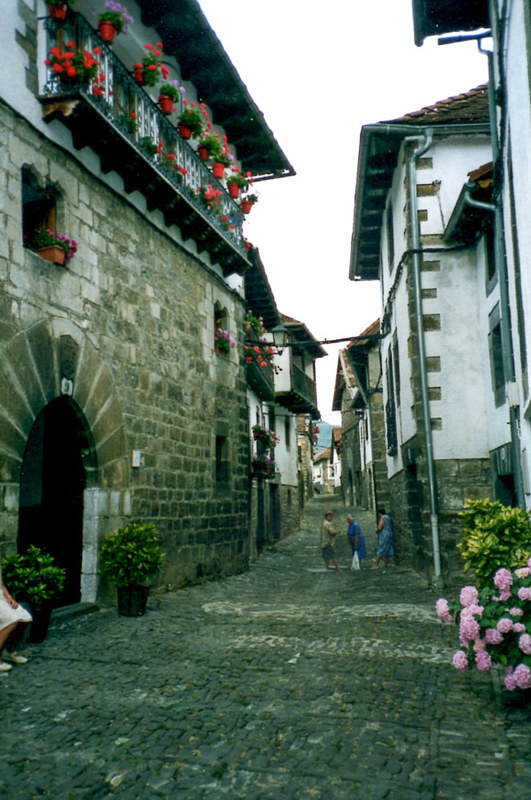
Ochagavia is a stunning chocolate-box village of whitewashed stone houses, their balconies overflowing with geraniums; narrow, immaculate cobbled streets; a templar church and a crystal-clear river. We can’t appreciate it at the moment though, as we wonder like rabid dogs from one
casa rural (Navarrese bed-and-breakfasts) to the next – there may be twenty five of them here but all seem to be full. It’s Friday night and it seems the village is a popular retreat for Pamplonians escaping from the continuing chaos of the
San Fermin fiesta. Just as it seems we’ll have to give up we find a woman who has a room. Entering through the high-arched door we’re led into the inner hallway, cobbled in a striking star-shaped design, and up the dark wood staircase into the beautiful family home above. After showering our grime away we collapse on our bed until it’s time to go out for dinner.
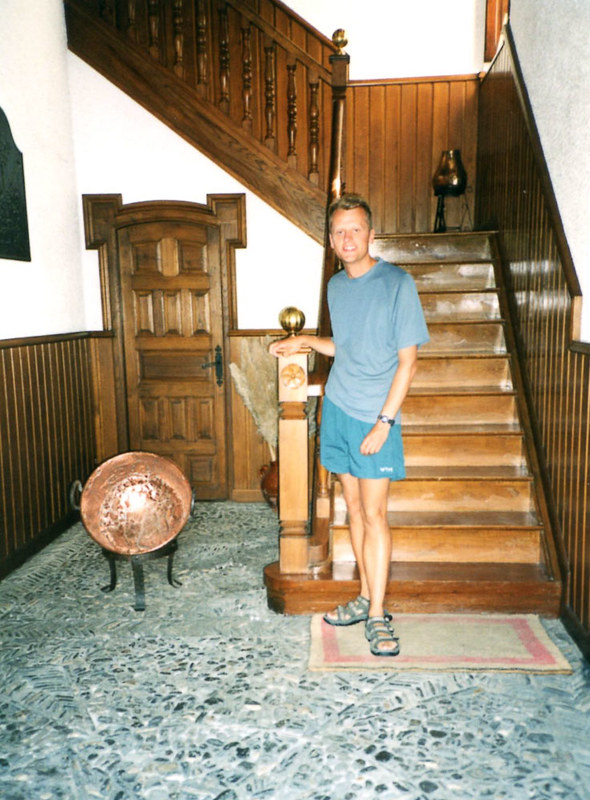 Day 44
Day 44Yesterday's heat and dehydration has left us exhausted and we really need to take a day off. We spend it doing virtually nothing except eating. The buffet breakfast in the Casa Rural seems a real luxury; the delicious hard local
roncal sheep cheese is perfect for lunch, and fresh local trout is perfect for dinner. By the end of the day our headaches are gone, but we’re going to have to be really careful to make sure we find enough water for the days ahead.
Day 45Another very steep climb is followed by a long walk on forest roads. The effort seems much less than a couple of days ago – which is a relief! When we emerge above the tree-line we again see the stark mountain outlines we’d glimpsed from the Paso Alfredo, but now they feel much closer at hand. The descent does begin to weary us though, being awkwardly steep and overgrown with sharp thorny bushes – my legs are soon covered in cuts and scratches. Helen shouts out as she narrowly avoids stepping on a huge, brightly coloured toad. We emerge at the
Ermita d’Idola, high above the settlement of Isaba. There seems to be one of these hermitage chapels for every village round here, acting a sort of party church in the hills used on the feast day of the local patron saint. This one is set in a beautifully tended hillside garden, where we rest with another couple who have wondered up from the village. They are the first people we’ve seen all day.
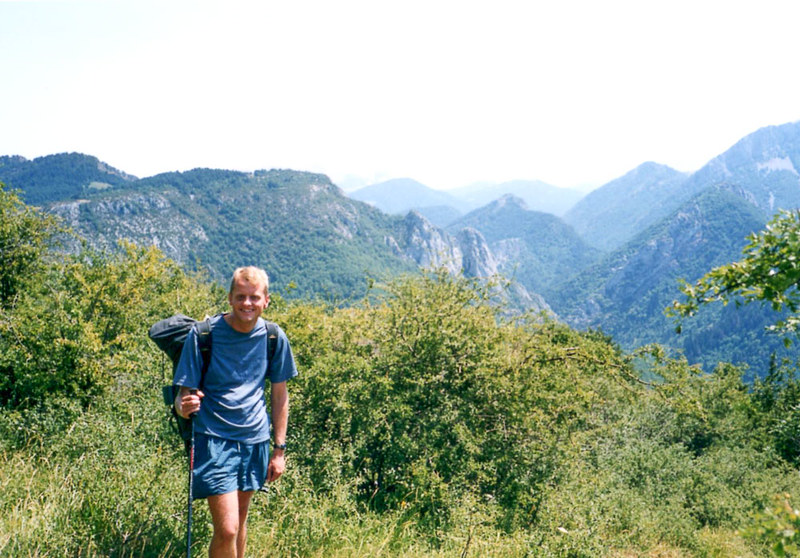
At the bottom of the hill we find Isaba is a wonderful little town, larger than Ochagavia but not quite so immaculately manicured. It has a more genuine, lived-in feel – and is much more closely cradled by the encircling mountains. We check into another casa rural for a snooze before heading out to explore.
Today has turned out to be the day of the ‘Tribute of the Three Cows’, the towns’ main annual celebration. We seem to be meeting every major fiesta so far - I can’t understand how we keep timing things so perfectly! The townsfolk from Isaba walk ten kilometres up the valley to a mountain pass which forms the border with France. There they meet the villagers from the French side of the mountains who pay them a tribute of three cows in return for the use of the superior grazings on the Spanish side. The conditions of the tribute were laid down in a peace treaty, said to be the oldest still in force between European nations. The celebration has already taken place on the col earlier in the day, but we’re treated to the bizarre sight of the Spanish delegation arriving back in Isaba.
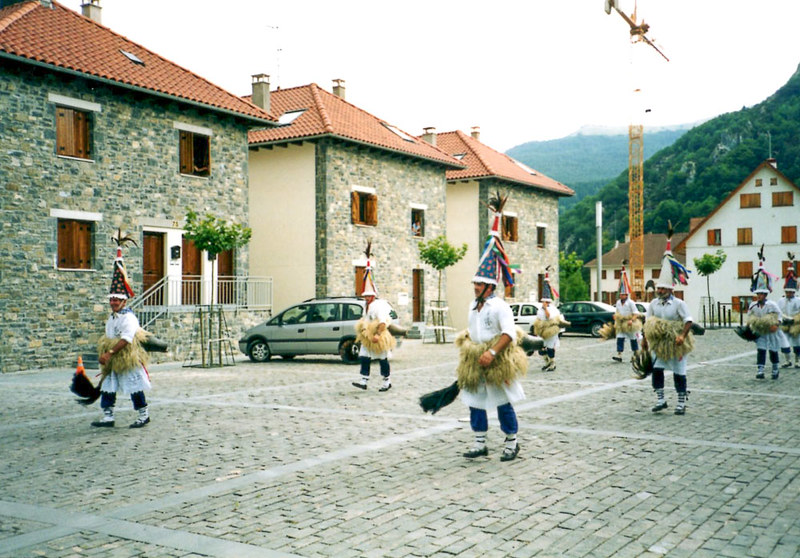
Twelve men march down the main street in the most ridiculous costumes imaginable, performing a dance in front of a block of houses though no-one else seems to be here to watch. They are wearing sandals held on by cross-tied leather straps wrapped around their thick socks; above these are short baggy trousers and long white jackets, around which are wrapped skirts made of straw. Tall, conical hats are tied on by straps under their chins, trailing multi-coloured streamers, whilst on the very top small plants seem to be sprouting. They are waving short-handled besoms in their left arms and while they march and dance a real racket is produced by huge pot-shaped brass bells, a pair of which is tied onto each mans’ buttocks. Ten minutes prancing and they’re off, back up the road from whence they came. They don’t even look ashamed!!
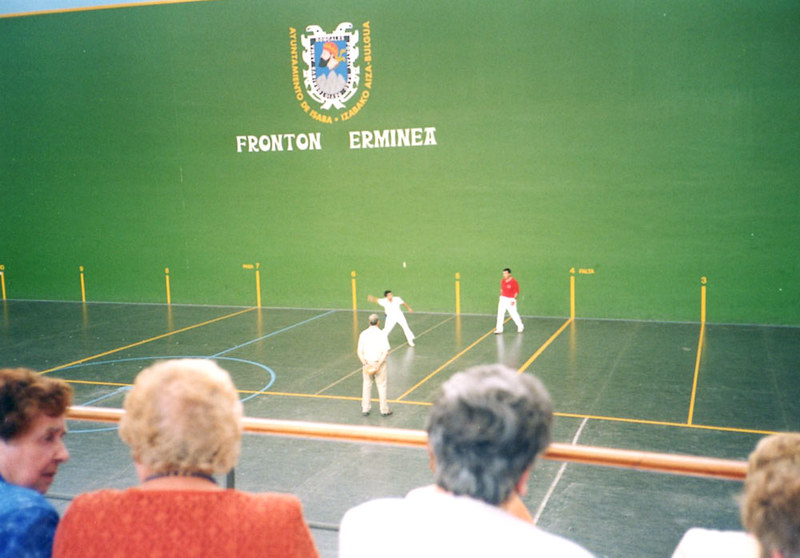
Groups of villagers are heading into the rectangular modern building at the foot of the town; we follow them and discover it’s an indoor pelota stadium – there’s to be a match between the French and Spanish villagers. The first game we see is played by teams of two, smashing a ball with wooden bats against a high wall – something like squash but with only two walls to hit and much more ground to cover. As this match ends a crowd of locals begins to gather for the main event, a singles match between two guys who stand about twenty yards from the wall, smacking the ball with their bare hands. It looks incredibly painful, and a burly man who whacks the ball full pelt every time is soon leading against an older player who has less power but more finesse, occasionally going for drop shots that leave the younger guy stranded. The older guy is clearly in some pain as he rubs his hands constantly between points, but his greater skill slowly reels in the advantage, and he eventually takes the match 22:21 to a standing ovation.
Day 46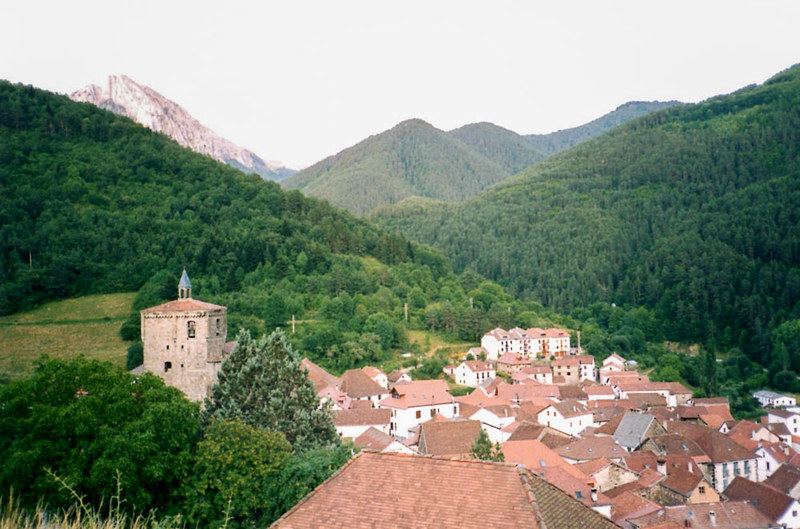
The GR11 has two options from Isaba, a steep rock scramble up a fearsome-looking peak known as Ezkaurre, first of the two-thousand metre mountains – or a shorter route through the forests to the north. We use the excuse of our heavy packs to go for the easier option. The problem with the path dividing is that the markings become even harder to follow than before. The sections through the trees are straightforward enough but each time we emerge into big grassy clearings there’s no clue as to which direction we should head next. We make only slow progress; I wouldn’t mind but every time we stop and try to work out our bearings we are attacked by hordes of giant horseflies, driving us crazy with bites.
By early afternoon we reach a huge campsite, seemingly in the middle of nowhere, and set up the tent. The scenery here is awe-inspiring: enormous peaks of bare rock tower above the vast forest. The area harbours some of western Europe’s last remaining population of indigenous brown bears; it’s easy to imagine them roaming here. For the third successive day the weather breaks in the late afternoon and pouring rain lashes against the side of the tent, which is lit by brilliant lightning – a warning that we’d better make sure we reach camp early over the next few days. Still, nothing can dampen our spirits – we’re amongst the real mountains at last.
[
Click for next stage]